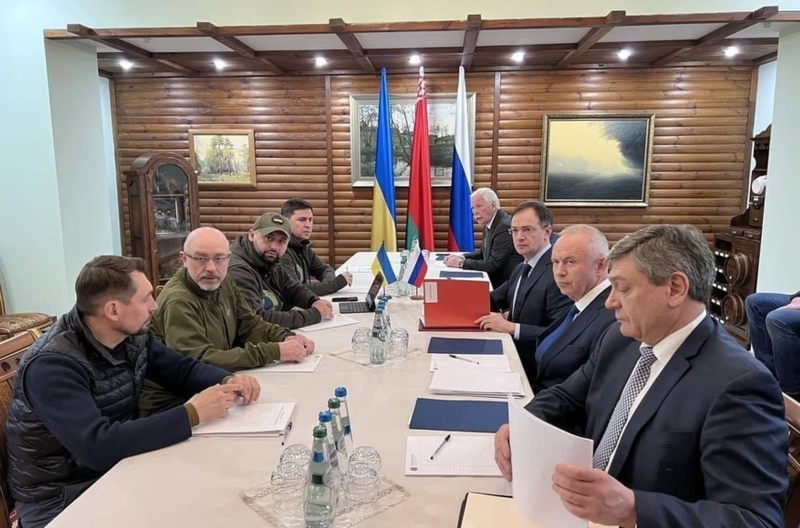Ukrainian Deputy Foreign Minister Mykola Tochytsky, Defense Minister Oleksii Reznikov, “Servant of the People” faction leader Davyd Arakhamia, Presidential Office adviser Mykhailo Podolyak, and representatives of Russia, including presidential aide Vladimir Medinsky, took part in negotiations on Mar 7, 2022
Radio Free Europe / Radio Liberty's investigation project Systema has published the earliest known draft of a peace treaty between Russia and Ukraine. Dated Mar. 7, 2022, the document details Vladimir Putin’s demands in exchange for a “ceasefire.”
The provisions effectively outline the same “objectives” of Russia’s so-called “special military operation” that have been frequently mentioned by Vladimir Putin. Notably, the document does not put on offer any withdrawal of Russian troops from Ukraine.
The six-page document, provided to Systema by a Ukrainian source familiar with the negotiations, was confirmed as authentic by a Russian source. Both requested anonymity, as they were not authorized to comment on the matter publicly.
Negotiations over a potential peace deal began in Belarus just days after Moscow unleashed its full-scale invasion. By the third round of negotiations on Mar. 7, concrete documents were being discussed, including the “Treaty on Ukraine’s Neutrality,” drafted in Moscow and brought to Belarus by Putin aide Vladimir Medinsky and his team.
At this stage, Russia was waging intense battles for Kyiv and Mariupol and had occupied several eastern Ukrainian regions. Failing to capture Kyiv within the anticipated “three days” and facing resistance from Ukrainian forces, Russia proposed “ceasefire measures” in return for Ukraine’s agreement to a series of demands.
In June of this year, The New York Times (NYT) published the complete 17-page draft of a purported Ukraine-Russia peace treaty, dated Apr. 15, 2022. While that document retained elements from the initial draft, such as an insistence on lifting all sanctions against Moscow, Russia had tempered some of its other demands. The earlier version of the document included the following points.
Russia’s demands as of Mar. 7, 2022:
- Reduce the Ukrainian army to 50,000 personnel, including 1,500 officers (five times smaller than Ukraine’s pre-2022 strength), leaving Ukraine with only four ships, 55 helicopters, and 300 tanks.
- Bar Ukraine from joining military alliances or signing military agreements with other states.
- Prohibit Ukraine from “developing, producing, acquiring, or deploying missiles of any kind with a range over 250 km on its territory.”
- Require Ukraine to “recognize the independence” of the so-called Donetsk and Luhansk “people’s republics” and acknowledge Crimea and Sevastopol as “integral parts of Russia.”
- Obligate Ukraine to bear the cost of rebuilding Donbas infrastructure damaged since 2014 and then relinquish these regions to Russia.
- Demand the removal of all sanctions against Russia, including Ukrainian and Western sanctions, and the withdrawal of all international lawsuits filed since 2014.
- Establish Russian as a state language in Ukraine.
- Rescind and permanently ban “any prohibitions on symbols associated with the victory over Nazism,” effectively requiring Ukraine to reauthorize Soviet and Communist symbols. The demand included a list of Ukrainian laws deemed by Russia to represent “Nazification and heroization of Nazism” — including laws “On the Commemoration of the Victory over Nazism” and “On the Rehabilitation of Victims of Communist Totalitarian Repression.”
- Halt Ukraine’s process of joining the Rome Statute of the International Criminal Court (which would later issue an arrest warrant for Putin).
- Prohibit other countries from engaging in military cooperation with Ukraine or using Ukrainian territory for military deployments or exercises.
What Ukraine would receive in return:
The Russian side appeared to propose a “ceasefire regime,” along with a series of unspecified “measures” that notably did not include a troop withdrawal. Ukraine, however, was required to relocate all its forces to permanent stations (or locations “designated by Russia”), and Kyiv’s foreign partners were to immediately halt all assistance and withdraw any personnel connected to Ukraine’s military formations — including military advisors.
According to the document, Russian troops and national guard forces were to remain on-site to monitor Ukraine’s adherence to “all treaty obligations.”
There were no additional conditions in the document. Essentially, the document consisted solely of demands placed on Ukraine in exchange for a “ceasefire regime,” while Russian forces would remain in their positions, which at that time included the occupation of Kyiv suburbs such as Bucha.
What eventually happened:
No peace agreement has been reached between Russia and Ukraine, and Moscow’s full-scale invasion is nearing the end of its third year. The latest known draft of the potential peace treaty — dated Apr. 15, 2022 and published by the NYT earlier this year — showed only minor changes from the initial version. Notably, the clause on Ukraine’s ability to receive military aid in the event of renewed threats was revised: Kyiv wanted signatory states to provide aid both jointly and individually, while Russia insisted that any decision be made collectively and include Russian involvement. This means Russia was demanding that third countries receive Moscow’s permission before sending military aid to Kyiv, even in a scenario in which Russia resumed its full-scale assault on Ukraine.
Ukraine firmly rejected this condition. Other major unresolved issues included territorial boundaries and the extent of Ukraine’s security guarantees, ultimately leading to the rejection of the draft.

